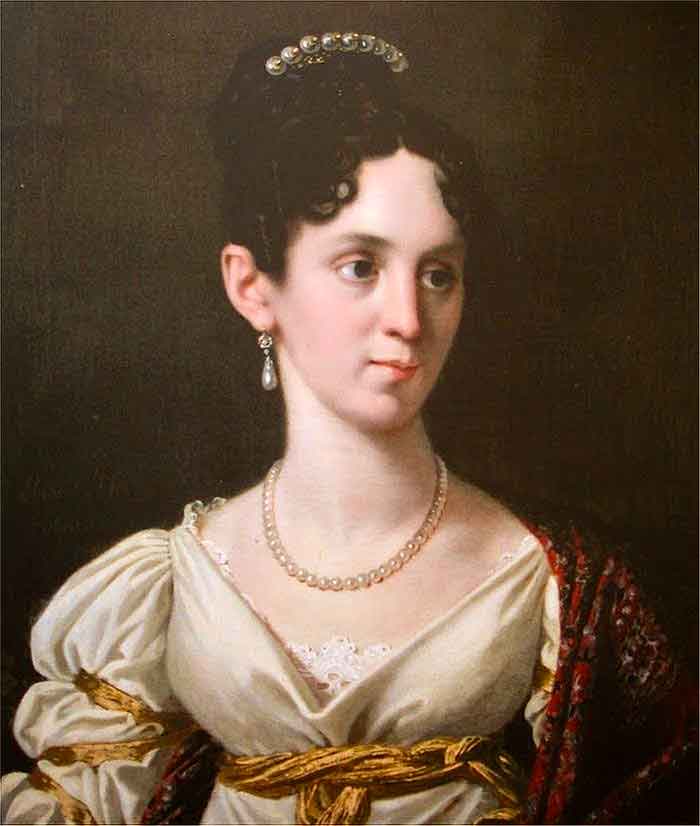.
Sophie de Marbois-Lebrun, Duchess of Plaisance (Greek: Δούκισσα της Πλακεντίας) (1785-1854) was born in Philadelphia, Pennsylvania, where her father, François Barbé-Marbois, was serving as French Consul-General to the United States.

Duchess of Plaisance
In 1804, Sophie married Charles-François Lebrun later duc de Plaisance, who along with Napoleon Bonaparte had served as one of three Consuls of France from 1799-1804. They had one daughter Eliza (Elizabeth). The marriage was an unhappy one and the couple separated without ever being divorced; Sophie lived in Italy while the Duc was Governor of Holland from 1811-1813.
Upon the outbreak of the Greek War of Independence, the Duchess and her daughter gave generously to the Greek cause and in 1830, they moved to Nafplion, the then-capital of Greece and she was reaquainted with the Greek leader John Capodistria whom she had met in Paris in 1826. She became an ardent financial supporter of public education. Eventually, she became an opponent of Capodistria, and after a 17-month stay, she departed for Italy. When Capodistria was assassinated by Konstantinos Mavromichalis and his nephew Gorgeos Mavromichalis, she spoke out against the way Capodistria had run the Greek government.
In 1834, the Duchess returned to Greece and settled in the new capital Athens. She purchased large amounts of agricultural land chiefly near Mt. Penteli, but all around Athens. She engaged the Greek architect, Stamatios Kleanthis to design a palace for her on the slopes of Mt. Penteli. Meanwhile, in 1836, the Duchess and her daughter traveled to Beirut but Eliza died of pneumonia. Such was the sorrow of the Duchess that she had her daughter's body embalmed and returned to Athens where it was placed in a crypt under her temporary home on Peiraios Street.
Kleanthis completed the Tower of the Duchess of Plaisance in 1841 and then set to work on Villa Illisia, which was completed in 1848. Today the Villa Illisia is the site of the Byzantine Museum. A central fixture in the social life of Othonian Athens, the Duchess would host symposia on various topices of religion and politics in her palace. She was also known to dole out funds and titles of courtesy to those whom she found favor. Something of an iconoclast, the Duchess rejected the prevailing faith, Greek Orthodoxy, and instead converted to Judaism. She sponsored the building of a Jewish temple in Halkida, Euboea.
Later in life, she commissioned Kleanthis to begin a final home and a resting place for her beloved daughter's remains, the Castle of Rododafni. She would never see the house completed. In 1847, it caught fire and was burned to the ground. After that, the Duchess withdrew from public life only agreeing to see her old friend, Fotini Mavromichali, Lady-in-waiting for Queen consort Amalia of Oldenburg . She died in 1854 and her nephew sold her lands to the Greek state. She is buried with her daughter in her Tower near Penteli.
Today an Athens Metro station, built on her original lands, is named Doukissis Plakentias station (Δουκίσσης Πλακεντίας).
| Ancient Greece
Science, Technology , Medicine , Warfare, , Biographies , Life , Cities/Places/Maps , Arts , Literature , Philosophy ,Olympics, Mythology , History , Images Medieval Greece / Byzantine Empire Science, Technology, Arts, , Warfare , Literature, Biographies, Icons, History Modern Greece Cities, Islands, Regions, Fauna/Flora ,Biographies , History , Warfare, Science/Technology, Literature, Music , Arts , Film/Actors , Sport , Fashion --- |
Retrieved from "http://en.wikipedia.org"
All text is available under the terms of the GNU Free Documentation License

